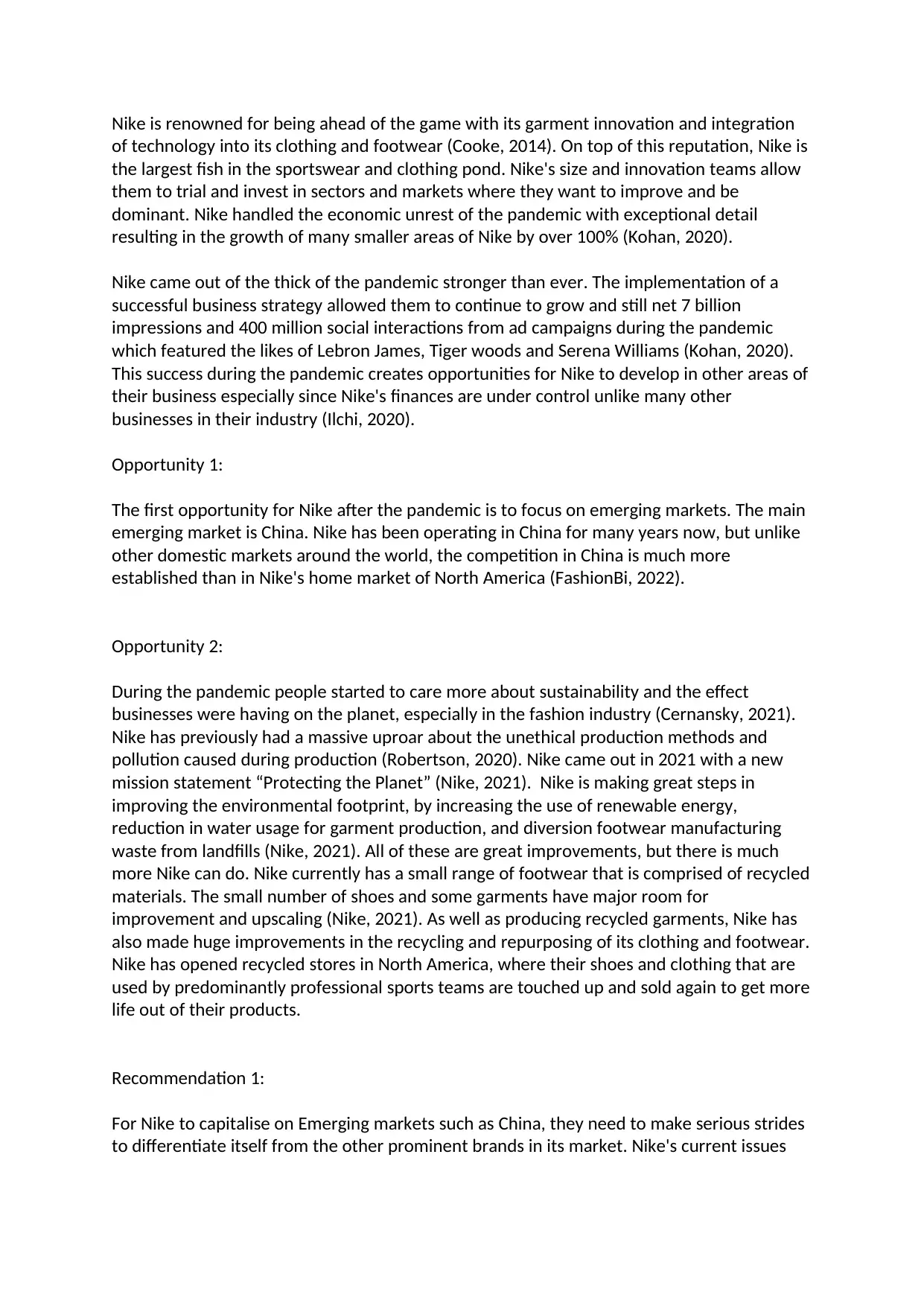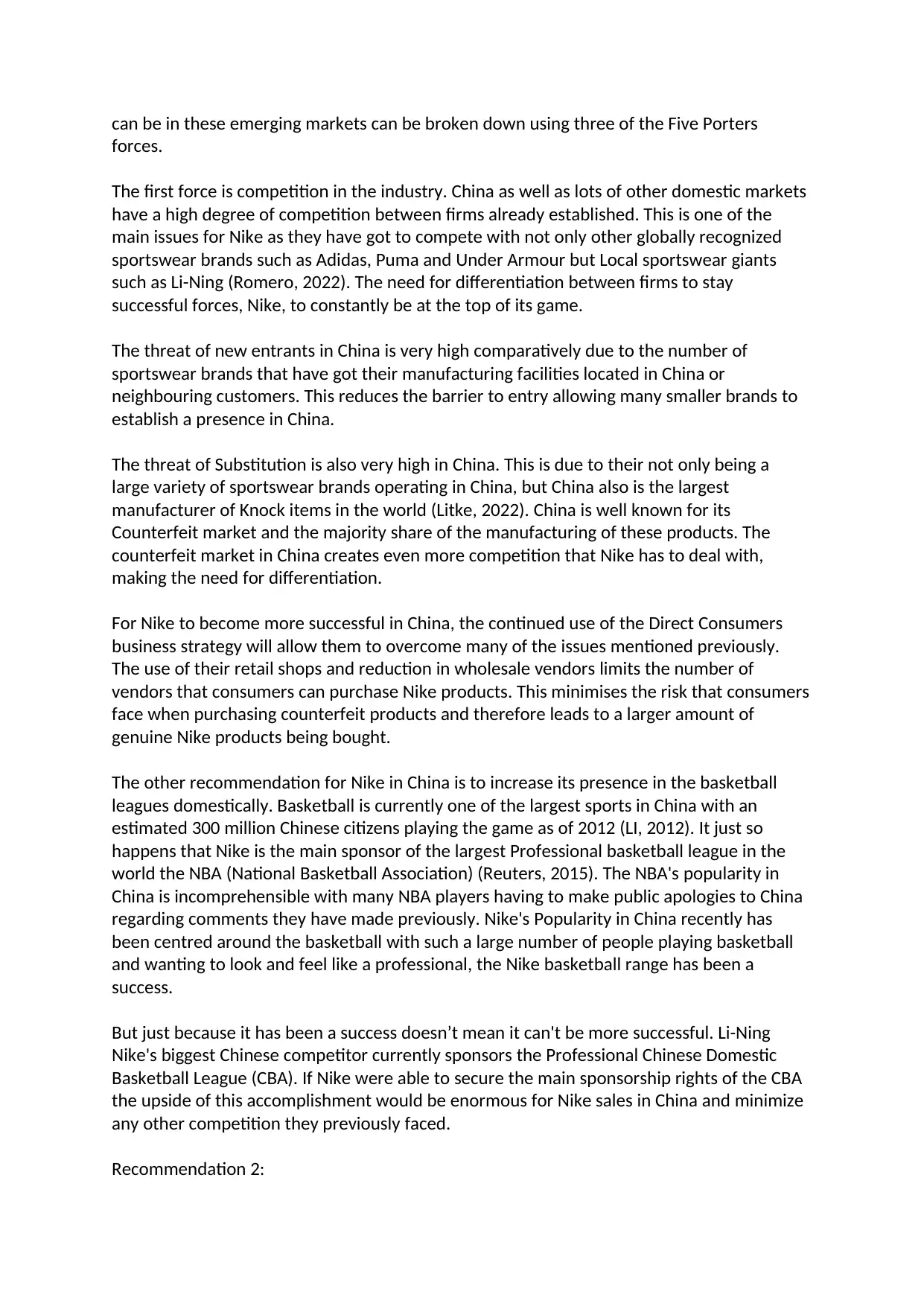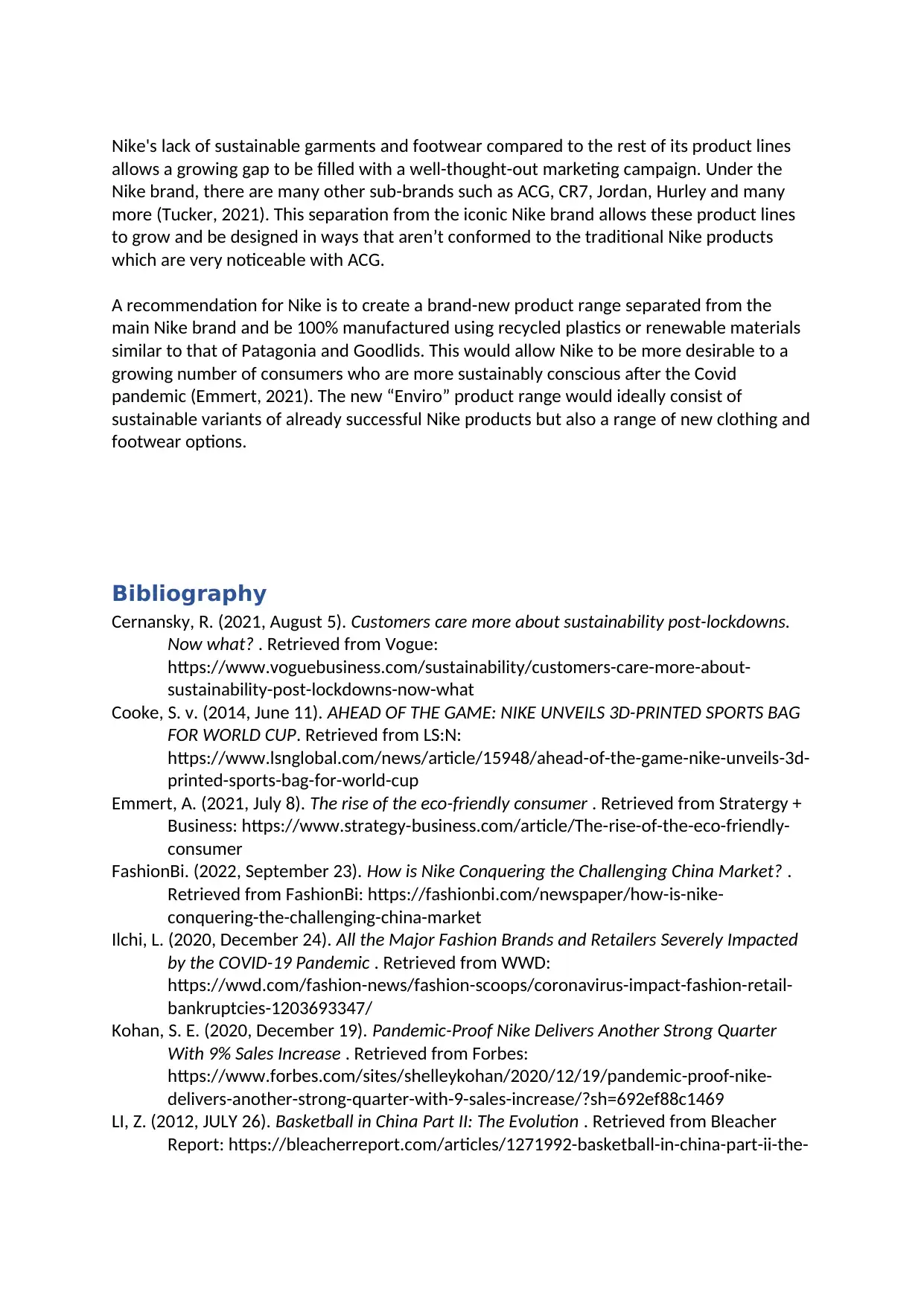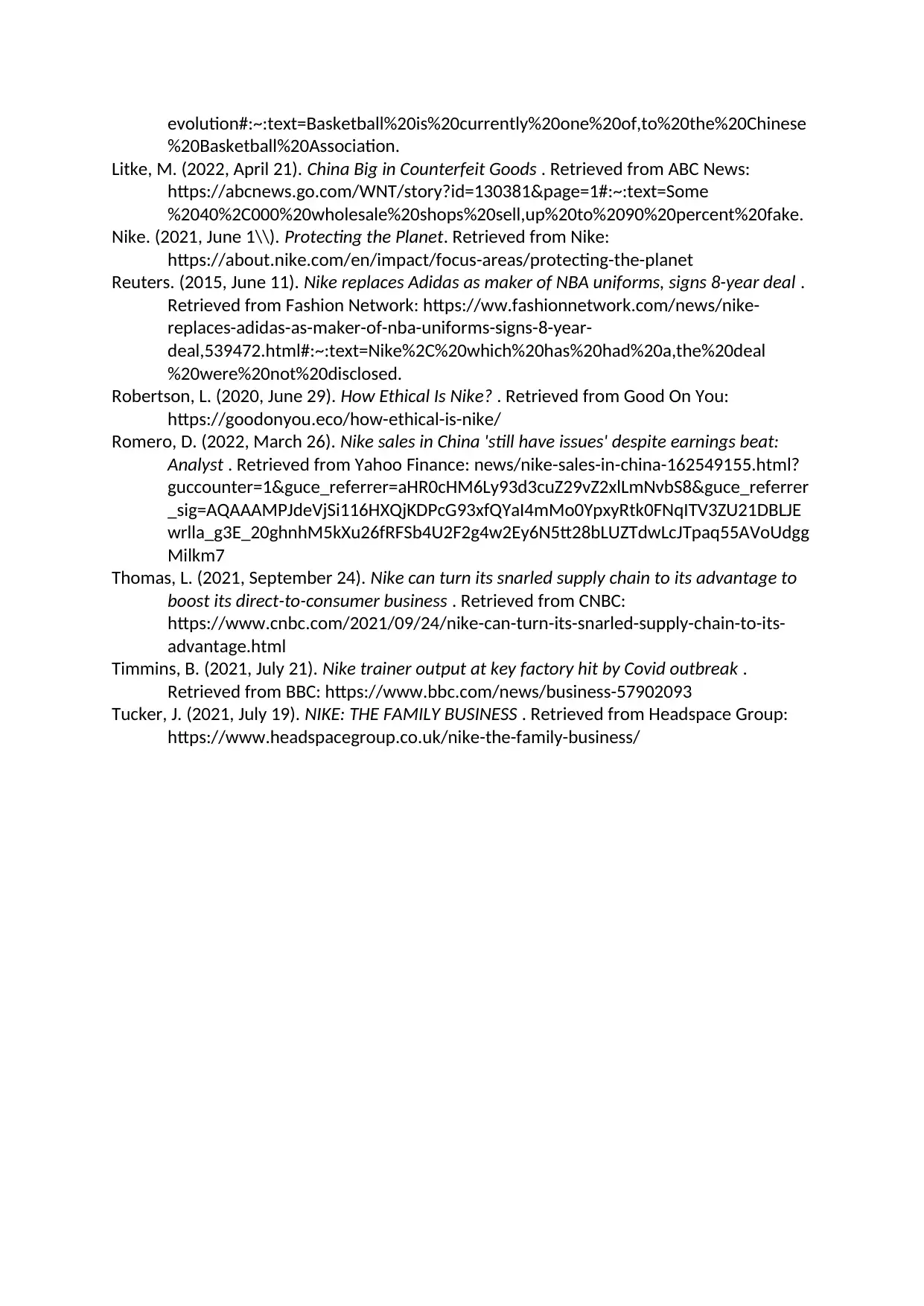Nike's Strategies for Growth in Emerging Markets and Sustainability
VerifiedAdded on 2023/01/18
|4
|1781
|69
Report
AI Summary
This report analyzes Nike's post-pandemic business strategy, focusing on opportunities in emerging markets, particularly China, and the increasing importance of sustainability. The report highlights Nike's strengths, including its innovation and brand recognition, while also addressing challenges like competition in China and the need for more sustainable practices. It recommends that Nike differentiate itself in the Chinese market using the Direct Consumers business strategy and increasing presence in the basketball leagues. Furthermore, it suggests the creation of a new sustainable product line to capitalize on growing consumer demand for eco-friendly products. The report uses Porter's Five Forces to analyze the competitive landscape and provides recommendations for Nike to maintain its market leadership and adapt to evolving consumer preferences.

Nike is renowned for being ahead of the game with its garment innovation and integration
of technology into its clothing and footwear (Cooke, 2014). On top of this reputation, Nike is
the largest fish in the sportswear and clothing pond. Nike's size and innovation teams allow
them to trial and invest in sectors and markets where they want to improve and be
dominant. Nike handled the economic unrest of the pandemic with exceptional detail
resulting in the growth of many smaller areas of Nike by over 100% (Kohan, 2020).
Nike came out of the thick of the pandemic stronger than ever. The implementation of a
successful business strategy allowed them to continue to grow and still net 7 billion
impressions and 400 million social interactions from ad campaigns during the pandemic
which featured the likes of Lebron James, Tiger woods and Serena Williams (Kohan, 2020).
This success during the pandemic creates opportunities for Nike to develop in other areas of
their business especially since Nike's finances are under control unlike many other
businesses in their industry (Ilchi, 2020).
Opportunity 1:
The first opportunity for Nike after the pandemic is to focus on emerging markets. The main
emerging market is China. Nike has been operating in China for many years now, but unlike
other domestic markets around the world, the competition in China is much more
established than in Nike's home market of North America (FashionBi, 2022).
Opportunity 2:
During the pandemic people started to care more about sustainability and the effect
businesses were having on the planet, especially in the fashion industry (Cernansky, 2021).
Nike has previously had a massive uproar about the unethical production methods and
pollution caused during production (Robertson, 2020). Nike came out in 2021 with a new
mission statement “Protecting the Planet” (Nike, 2021). Nike is making great steps in
improving the environmental footprint, by increasing the use of renewable energy,
reduction in water usage for garment production, and diversion footwear manufacturing
waste from landfills (Nike, 2021). All of these are great improvements, but there is much
more Nike can do. Nike currently has a small range of footwear that is comprised of recycled
materials. The small number of shoes and some garments have major room for
improvement and upscaling (Nike, 2021). As well as producing recycled garments, Nike has
also made huge improvements in the recycling and repurposing of its clothing and footwear.
Nike has opened recycled stores in North America, where their shoes and clothing that are
used by predominantly professional sports teams are touched up and sold again to get more
life out of their products.
Recommendation 1:
For Nike to capitalise on Emerging markets such as China, they need to make serious strides
to differentiate itself from the other prominent brands in its market. Nike's current issues
of technology into its clothing and footwear (Cooke, 2014). On top of this reputation, Nike is
the largest fish in the sportswear and clothing pond. Nike's size and innovation teams allow
them to trial and invest in sectors and markets where they want to improve and be
dominant. Nike handled the economic unrest of the pandemic with exceptional detail
resulting in the growth of many smaller areas of Nike by over 100% (Kohan, 2020).
Nike came out of the thick of the pandemic stronger than ever. The implementation of a
successful business strategy allowed them to continue to grow and still net 7 billion
impressions and 400 million social interactions from ad campaigns during the pandemic
which featured the likes of Lebron James, Tiger woods and Serena Williams (Kohan, 2020).
This success during the pandemic creates opportunities for Nike to develop in other areas of
their business especially since Nike's finances are under control unlike many other
businesses in their industry (Ilchi, 2020).
Opportunity 1:
The first opportunity for Nike after the pandemic is to focus on emerging markets. The main
emerging market is China. Nike has been operating in China for many years now, but unlike
other domestic markets around the world, the competition in China is much more
established than in Nike's home market of North America (FashionBi, 2022).
Opportunity 2:
During the pandemic people started to care more about sustainability and the effect
businesses were having on the planet, especially in the fashion industry (Cernansky, 2021).
Nike has previously had a massive uproar about the unethical production methods and
pollution caused during production (Robertson, 2020). Nike came out in 2021 with a new
mission statement “Protecting the Planet” (Nike, 2021). Nike is making great steps in
improving the environmental footprint, by increasing the use of renewable energy,
reduction in water usage for garment production, and diversion footwear manufacturing
waste from landfills (Nike, 2021). All of these are great improvements, but there is much
more Nike can do. Nike currently has a small range of footwear that is comprised of recycled
materials. The small number of shoes and some garments have major room for
improvement and upscaling (Nike, 2021). As well as producing recycled garments, Nike has
also made huge improvements in the recycling and repurposing of its clothing and footwear.
Nike has opened recycled stores in North America, where their shoes and clothing that are
used by predominantly professional sports teams are touched up and sold again to get more
life out of their products.
Recommendation 1:
For Nike to capitalise on Emerging markets such as China, they need to make serious strides
to differentiate itself from the other prominent brands in its market. Nike's current issues
Paraphrase This Document
Need a fresh take? Get an instant paraphrase of this document with our AI Paraphraser

can be in these emerging markets can be broken down using three of the Five Porters
forces.
The first force is competition in the industry. China as well as lots of other domestic markets
have a high degree of competition between firms already established. This is one of the
main issues for Nike as they have got to compete with not only other globally recognized
sportswear brands such as Adidas, Puma and Under Armour but Local sportswear giants
such as Li-Ning (Romero, 2022). The need for differentiation between firms to stay
successful forces, Nike, to constantly be at the top of its game.
The threat of new entrants in China is very high comparatively due to the number of
sportswear brands that have got their manufacturing facilities located in China or
neighbouring customers. This reduces the barrier to entry allowing many smaller brands to
establish a presence in China.
The threat of Substitution is also very high in China. This is due to their not only being a
large variety of sportswear brands operating in China, but China also is the largest
manufacturer of Knock items in the world (Litke, 2022). China is well known for its
Counterfeit market and the majority share of the manufacturing of these products. The
counterfeit market in China creates even more competition that Nike has to deal with,
making the need for differentiation.
For Nike to become more successful in China, the continued use of the Direct Consumers
business strategy will allow them to overcome many of the issues mentioned previously.
The use of their retail shops and reduction in wholesale vendors limits the number of
vendors that consumers can purchase Nike products. This minimises the risk that consumers
face when purchasing counterfeit products and therefore leads to a larger amount of
genuine Nike products being bought.
The other recommendation for Nike in China is to increase its presence in the basketball
leagues domestically. Basketball is currently one of the largest sports in China with an
estimated 300 million Chinese citizens playing the game as of 2012 (LI, 2012). It just so
happens that Nike is the main sponsor of the largest Professional basketball league in the
world the NBA (National Basketball Association) (Reuters, 2015). The NBA's popularity in
China is incomprehensible with many NBA players having to make public apologies to China
regarding comments they have made previously. Nike's Popularity in China recently has
been centred around the basketball with such a large number of people playing basketball
and wanting to look and feel like a professional, the Nike basketball range has been a
success.
But just because it has been a success doesn’t mean it can't be more successful. Li-Ning
Nike's biggest Chinese competitor currently sponsors the Professional Chinese Domestic
Basketball League (CBA). If Nike were able to secure the main sponsorship rights of the CBA
the upside of this accomplishment would be enormous for Nike sales in China and minimize
any other competition they previously faced.
Recommendation 2:
forces.
The first force is competition in the industry. China as well as lots of other domestic markets
have a high degree of competition between firms already established. This is one of the
main issues for Nike as they have got to compete with not only other globally recognized
sportswear brands such as Adidas, Puma and Under Armour but Local sportswear giants
such as Li-Ning (Romero, 2022). The need for differentiation between firms to stay
successful forces, Nike, to constantly be at the top of its game.
The threat of new entrants in China is very high comparatively due to the number of
sportswear brands that have got their manufacturing facilities located in China or
neighbouring customers. This reduces the barrier to entry allowing many smaller brands to
establish a presence in China.
The threat of Substitution is also very high in China. This is due to their not only being a
large variety of sportswear brands operating in China, but China also is the largest
manufacturer of Knock items in the world (Litke, 2022). China is well known for its
Counterfeit market and the majority share of the manufacturing of these products. The
counterfeit market in China creates even more competition that Nike has to deal with,
making the need for differentiation.
For Nike to become more successful in China, the continued use of the Direct Consumers
business strategy will allow them to overcome many of the issues mentioned previously.
The use of their retail shops and reduction in wholesale vendors limits the number of
vendors that consumers can purchase Nike products. This minimises the risk that consumers
face when purchasing counterfeit products and therefore leads to a larger amount of
genuine Nike products being bought.
The other recommendation for Nike in China is to increase its presence in the basketball
leagues domestically. Basketball is currently one of the largest sports in China with an
estimated 300 million Chinese citizens playing the game as of 2012 (LI, 2012). It just so
happens that Nike is the main sponsor of the largest Professional basketball league in the
world the NBA (National Basketball Association) (Reuters, 2015). The NBA's popularity in
China is incomprehensible with many NBA players having to make public apologies to China
regarding comments they have made previously. Nike's Popularity in China recently has
been centred around the basketball with such a large number of people playing basketball
and wanting to look and feel like a professional, the Nike basketball range has been a
success.
But just because it has been a success doesn’t mean it can't be more successful. Li-Ning
Nike's biggest Chinese competitor currently sponsors the Professional Chinese Domestic
Basketball League (CBA). If Nike were able to secure the main sponsorship rights of the CBA
the upside of this accomplishment would be enormous for Nike sales in China and minimize
any other competition they previously faced.
Recommendation 2:

Nike's lack of sustainable garments and footwear compared to the rest of its product lines
allows a growing gap to be filled with a well-thought-out marketing campaign. Under the
Nike brand, there are many other sub-brands such as ACG, CR7, Jordan, Hurley and many
more (Tucker, 2021). This separation from the iconic Nike brand allows these product lines
to grow and be designed in ways that aren’t conformed to the traditional Nike products
which are very noticeable with ACG.
A recommendation for Nike is to create a brand-new product range separated from the
main Nike brand and be 100% manufactured using recycled plastics or renewable materials
similar to that of Patagonia and Goodlids. This would allow Nike to be more desirable to a
growing number of consumers who are more sustainably conscious after the Covid
pandemic (Emmert, 2021). The new “Enviro” product range would ideally consist of
sustainable variants of already successful Nike products but also a range of new clothing and
footwear options.
Bibliography
Cernansky, R. (2021, August 5). Customers care more about sustainability post-lockdowns.
Now what? . Retrieved from Vogue:
https://www.voguebusiness.com/sustainability/customers-care-more-about-
sustainability-post-lockdowns-now-what
Cooke, S. v. (2014, June 11). AHEAD OF THE GAME: NIKE UNVEILS 3D-PRINTED SPORTS BAG
FOR WORLD CUP. Retrieved from LS:N:
https://www.lsnglobal.com/news/article/15948/ahead-of-the-game-nike-unveils-3d-
printed-sports-bag-for-world-cup
Emmert, A. (2021, July 8). The rise of the eco-friendly consumer . Retrieved from Stratergy +
Business: https://www.strategy-business.com/article/The-rise-of-the-eco-friendly-
consumer
FashionBi. (2022, September 23). How is Nike Conquering the Challenging China Market? .
Retrieved from FashionBi: https://fashionbi.com/newspaper/how-is-nike-
conquering-the-challenging-china-market
Ilchi, L. (2020, December 24). All the Major Fashion Brands and Retailers Severely Impacted
by the COVID-19 Pandemic . Retrieved from WWD:
https://wwd.com/fashion-news/fashion-scoops/coronavirus-impact-fashion-retail-
bankruptcies-1203693347/
Kohan, S. E. (2020, December 19). Pandemic-Proof Nike Delivers Another Strong Quarter
With 9% Sales Increase . Retrieved from Forbes:
https://www.forbes.com/sites/shelleykohan/2020/12/19/pandemic-proof-nike-
delivers-another-strong-quarter-with-9-sales-increase/?sh=692ef88c1469
LI, Z. (2012, JULY 26). Basketball in China Part II: The Evolution . Retrieved from Bleacher
Report: https://bleacherreport.com/articles/1271992-basketball-in-china-part-ii-the-
allows a growing gap to be filled with a well-thought-out marketing campaign. Under the
Nike brand, there are many other sub-brands such as ACG, CR7, Jordan, Hurley and many
more (Tucker, 2021). This separation from the iconic Nike brand allows these product lines
to grow and be designed in ways that aren’t conformed to the traditional Nike products
which are very noticeable with ACG.
A recommendation for Nike is to create a brand-new product range separated from the
main Nike brand and be 100% manufactured using recycled plastics or renewable materials
similar to that of Patagonia and Goodlids. This would allow Nike to be more desirable to a
growing number of consumers who are more sustainably conscious after the Covid
pandemic (Emmert, 2021). The new “Enviro” product range would ideally consist of
sustainable variants of already successful Nike products but also a range of new clothing and
footwear options.
Bibliography
Cernansky, R. (2021, August 5). Customers care more about sustainability post-lockdowns.
Now what? . Retrieved from Vogue:
https://www.voguebusiness.com/sustainability/customers-care-more-about-
sustainability-post-lockdowns-now-what
Cooke, S. v. (2014, June 11). AHEAD OF THE GAME: NIKE UNVEILS 3D-PRINTED SPORTS BAG
FOR WORLD CUP. Retrieved from LS:N:
https://www.lsnglobal.com/news/article/15948/ahead-of-the-game-nike-unveils-3d-
printed-sports-bag-for-world-cup
Emmert, A. (2021, July 8). The rise of the eco-friendly consumer . Retrieved from Stratergy +
Business: https://www.strategy-business.com/article/The-rise-of-the-eco-friendly-
consumer
FashionBi. (2022, September 23). How is Nike Conquering the Challenging China Market? .
Retrieved from FashionBi: https://fashionbi.com/newspaper/how-is-nike-
conquering-the-challenging-china-market
Ilchi, L. (2020, December 24). All the Major Fashion Brands and Retailers Severely Impacted
by the COVID-19 Pandemic . Retrieved from WWD:
https://wwd.com/fashion-news/fashion-scoops/coronavirus-impact-fashion-retail-
bankruptcies-1203693347/
Kohan, S. E. (2020, December 19). Pandemic-Proof Nike Delivers Another Strong Quarter
With 9% Sales Increase . Retrieved from Forbes:
https://www.forbes.com/sites/shelleykohan/2020/12/19/pandemic-proof-nike-
delivers-another-strong-quarter-with-9-sales-increase/?sh=692ef88c1469
LI, Z. (2012, JULY 26). Basketball in China Part II: The Evolution . Retrieved from Bleacher
Report: https://bleacherreport.com/articles/1271992-basketball-in-china-part-ii-the-
⊘ This is a preview!⊘
Do you want full access?
Subscribe today to unlock all pages.

Trusted by 1+ million students worldwide

evolution#:~:text=Basketball%20is%20currently%20one%20of,to%20the%20Chinese
%20Basketball%20Association.
Litke, M. (2022, April 21). China Big in Counterfeit Goods . Retrieved from ABC News:
https://abcnews.go.com/WNT/story?id=130381&page=1#:~:text=Some
%2040%2C000%20wholesale%20shops%20sell,up%20to%2090%20percent%20fake.
Nike. (2021, June 1\\). Protecting the Planet. Retrieved from Nike:
https://about.nike.com/en/impact/focus-areas/protecting-the-planet
Reuters. (2015, June 11). Nike replaces Adidas as maker of NBA uniforms, signs 8-year deal .
Retrieved from Fashion Network: https://ww.fashionnetwork.com/news/nike-
replaces-adidas-as-maker-of-nba-uniforms-signs-8-year-
deal,539472.html#:~:text=Nike%2C%20which%20has%20had%20a,the%20deal
%20were%20not%20disclosed.
Robertson, L. (2020, June 29). How Ethical Is Nike? . Retrieved from Good On You:
https://goodonyou.eco/how-ethical-is-nike/
Romero, D. (2022, March 26). Nike sales in China 'still have issues' despite earnings beat:
Analyst . Retrieved from Yahoo Finance: news/nike-sales-in-china-162549155.html?
guccounter=1&guce_referrer=aHR0cHM6Ly93d3cuZ29vZ2xlLmNvbS8&guce_referrer
_sig=AQAAAMPJdeVjSi116HXQjKDPcG93xfQYaI4mMo0YpxyRtk0FNqITV3ZU21DBLJE
wrlla_g3E_20ghnhM5kXu26fRFSb4U2F2g4w2Ey6N5tt28bLUZTdwLcJTpaq55AVoUdgg
Milkm7
Thomas, L. (2021, September 24). Nike can turn its snarled supply chain to its advantage to
boost its direct-to-consumer business . Retrieved from CNBC:
https://www.cnbc.com/2021/09/24/nike-can-turn-its-snarled-supply-chain-to-its-
advantage.html
Timmins, B. (2021, July 21). Nike trainer output at key factory hit by Covid outbreak .
Retrieved from BBC: https://www.bbc.com/news/business-57902093
Tucker, J. (2021, July 19). NIKE: THE FAMILY BUSINESS . Retrieved from Headspace Group:
https://www.headspacegroup.co.uk/nike-the-family-business/
%20Basketball%20Association.
Litke, M. (2022, April 21). China Big in Counterfeit Goods . Retrieved from ABC News:
https://abcnews.go.com/WNT/story?id=130381&page=1#:~:text=Some
%2040%2C000%20wholesale%20shops%20sell,up%20to%2090%20percent%20fake.
Nike. (2021, June 1\\). Protecting the Planet. Retrieved from Nike:
https://about.nike.com/en/impact/focus-areas/protecting-the-planet
Reuters. (2015, June 11). Nike replaces Adidas as maker of NBA uniforms, signs 8-year deal .
Retrieved from Fashion Network: https://ww.fashionnetwork.com/news/nike-
replaces-adidas-as-maker-of-nba-uniforms-signs-8-year-
deal,539472.html#:~:text=Nike%2C%20which%20has%20had%20a,the%20deal
%20were%20not%20disclosed.
Robertson, L. (2020, June 29). How Ethical Is Nike? . Retrieved from Good On You:
https://goodonyou.eco/how-ethical-is-nike/
Romero, D. (2022, March 26). Nike sales in China 'still have issues' despite earnings beat:
Analyst . Retrieved from Yahoo Finance: news/nike-sales-in-china-162549155.html?
guccounter=1&guce_referrer=aHR0cHM6Ly93d3cuZ29vZ2xlLmNvbS8&guce_referrer
_sig=AQAAAMPJdeVjSi116HXQjKDPcG93xfQYaI4mMo0YpxyRtk0FNqITV3ZU21DBLJE
wrlla_g3E_20ghnhM5kXu26fRFSb4U2F2g4w2Ey6N5tt28bLUZTdwLcJTpaq55AVoUdgg
Milkm7
Thomas, L. (2021, September 24). Nike can turn its snarled supply chain to its advantage to
boost its direct-to-consumer business . Retrieved from CNBC:
https://www.cnbc.com/2021/09/24/nike-can-turn-its-snarled-supply-chain-to-its-
advantage.html
Timmins, B. (2021, July 21). Nike trainer output at key factory hit by Covid outbreak .
Retrieved from BBC: https://www.bbc.com/news/business-57902093
Tucker, J. (2021, July 19). NIKE: THE FAMILY BUSINESS . Retrieved from Headspace Group:
https://www.headspacegroup.co.uk/nike-the-family-business/
1 out of 4
Your All-in-One AI-Powered Toolkit for Academic Success.
+13062052269
info@desklib.com
Available 24*7 on WhatsApp / Email
![[object Object]](/_next/static/media/star-bottom.7253800d.svg)
Unlock your academic potential
Copyright © 2020–2025 A2Z Services. All Rights Reserved. Developed and managed by ZUCOL.
